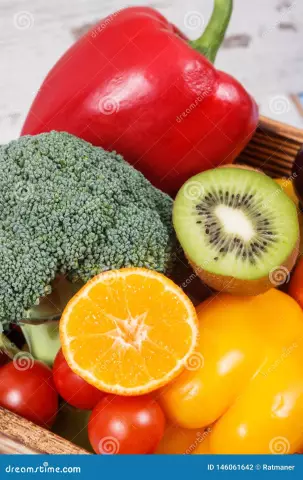- Author Rachel Wainwright [email protected].
- Public 2023-12-15 07:39.
- Last modified 2025-11-02 20:14.
Chard
Mangold belongs to plants from the amaranth family, which are closely related to sugar and fodder beets. Outwardly, the plant looks like spinach, has leaves up to 30 cm long, curly or straight type, which are edible.
The ratio of BJU in the product

Source: depositphotos.com How to burn 19 kcal?
| Walking | 5 minutes. |
| Jogging | 2 minutes. |
| Swimming | 2 minutes. |
| A bike | 3 min. |
| Aerobics | 4 minutes |
| Household chores | 6 minutes |
Biological features and distribution
There are two main types of chard - stem and chives. The stem type of the plant first appeared in Switzerland and is similar to asparagus. It has a reddish color of veins, fleshy and aromatic leaves, which are eaten.
Deciduous schnitt chard is a hardy, early plant that resembles a rosette and has loose leaves. Leafy varieties of chard must be sown on non-acidic soils with good moisture at a distance of about 20 cm from each other, then the plant will have large leaves and a pleasant taste.
A large number of Swiss chard varieties are widespread in Western Europe and Latin America, India, the Baltics, Japan, western regions of Russia and Ukraine.
Calorie content of chard
Swiss chard contains vitamins A, E and K, sodium, magnesium, potassium and iron. There is a lot of sugar in the roots of the plant, just like sugar beets.
The calorie content of chard is 19 kcal. Each plant contains 1.7 g of proteins, 0.2 g of fat and 3 g of carbohydrates, as well as fatty acids 0.03 g, disaccharides 1 g, ash and water.
Useful properties of chard
The benefits of chard are high and have been described in ancient medical treatises, where it was indicated that the juice of the leaves of the plant is a laxative, diuretic and general tonic, and also helps to treat dandruff.
The fleshy and juicy leaves of chard are rich in vitamins of the PP, A, B and E groups, and also contain a large amount of nitrogenous substances, organic acids, phosphorus, calcium, iron, lithium, potassium and carbohydrates.
The benefits of chard are preserved when used in salads, soups, cold dishes and stews. The stalks of the plant can be boiled or fried in oil, and also fermented with cabbage.
Due to its beneficial properties, Swiss chard is effective for the treatment of urolithiasis, hypotension, diabetes mellitus and anemia.
With regular consumption of Swiss chard, the functioning of the cardiovascular system, liver, brain and lymphatic system improves. The plant strengthens the immune system and enhances the protective functions of the body.
Mangold is useful as part of dietary food for making borscht, salads and snacks. With the constant addition of the plant to various dishes, toxins and harmful substances are removed from the body.
Cooking Swiss chard
Mangold is popular in various countries of the world, and is also included in many dishes, not only as a main ingredient, but also for decoration. Various appetizers, salads and meat dishes can be laid out on Swiss chard leaves. Freshly cut chard is great for salads and side dishes.
The traditional Italian dish is the Bieta salad with the fleshy and juicy leaves of this plant. Also, in many European countries, beetroot soup, vinaigrette, soups and aspic with the addition of this plant are popular. Chard stalks are used to preserve cucumbers and other vegetables.

Contraindications to use
Chard should not be eaten in case of individual intolerance and the presence of allergic reactions. This plant can cause drowsiness, nausea and vomiting, a sharp drop in blood pressure, as it contains many volatile substances.
It is not recommended to consume large amounts of juice from the leaves of this plant, which can cause a decrease in heart rate, dizziness and headache.
YouTube video related to the article:
Found a mistake in the text? Select it and press Ctrl + Enter.






